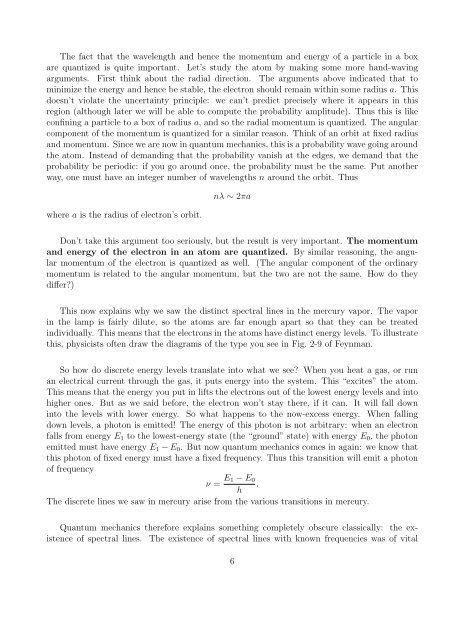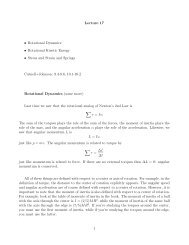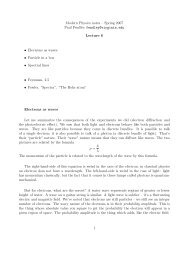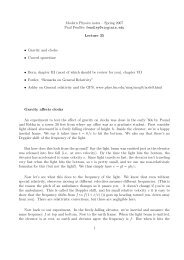Modern Physics notes Paul Fendley fendley@virginia.edu Lecture 6 ...
Modern Physics notes Paul Fendley fendley@virginia.edu Lecture 6 ...
Modern Physics notes Paul Fendley fendley@virginia.edu Lecture 6 ...
You also want an ePaper? Increase the reach of your titles
YUMPU automatically turns print PDFs into web optimized ePapers that Google loves.
The fact that the wavelength and hence the momentum and energy of a particle in a box<br />
are quantized is quite important. Let’s study the atom by making some more hand-waving<br />
arguments. First think about the radial direction. The arguments above indicated that to<br />
minimize the energy and hence be stable, the electron should remain within some radius a. This<br />
doesn’t violate the uncertainty principle: we can’t predict precisely where it appears in this<br />
region (although later we will be able to compute the probability amplitude). Thus this is like<br />
confining a particle to a box of radius a, and so the radial momentum is quantized. The angular<br />
component of the momentum is quantized for a similar reason. Think of an orbit at fixed radius<br />
and momentum. Since we are now in quantum mechanics, this is a probability wave going around<br />
the atom. Instead of demanding that the probability vanish at the edges, we demand that the<br />
probability be periodic: if you go around once, the probability must be the same. Put another<br />
way, one must have an integer number of wavelengths n around the orbit. Thus<br />
where a is the radius of electron’s orbit.<br />
nλ ∼ 2πa<br />
Don’t take this argument too seriously, but the result is very important. The momentum<br />
and energy of the electron in an atom are quantized. By similar reasoning, the angular<br />
momentum of the electron is quantized as well. (The angular component of the ordinary<br />
momentum is related to the angular momentum, but the two are not the same. How do they<br />
differ?)<br />
This now explains why we saw the distinct spectral lines in the mercury vapor. The vapor<br />
in the lamp is fairly dilute, so the atoms are far enough apart so that they can be treated<br />
individually. This means that the electrons in the atoms have distinct energy levels. To illustrate<br />
this, physicists often draw the diagrams of the type you see in Fig. 2-9 of Feynman.<br />
So how do discrete energy levels translate into what we see? When you heat a gas, or run<br />
an electrical current through the gas, it puts energy into the system. This “excites” the atom.<br />
This means that the energy you put in lifts the electrons out of the lowest energy levels and into<br />
higher ones. But as we said before, the electron won’t stay there, if it can. It will fall down<br />
into the levels with lower energy. So what happens to the now-excess energy. When falling<br />
down levels, a photon is emitted! The energy of this photon is not arbitrary: when an electron<br />
falls from energy E 1 to the lowest-energy state (the “ground” state) with energy E 0 , the photon<br />
emitted must have energy E 1 − E 0 . But now quantum mechanics comes in again: we know that<br />
this photon of fixed energy must have a fixed frequency. Thus this transition will emit a photon<br />
of frequency<br />
ν = E 1 − E 0<br />
.<br />
h<br />
The discrete lines we saw in mercury arise from the various transitions in mercury.<br />
Quantum mechanics therefore explains something completely obscure classically: the existence<br />
of spectral lines. The existence of spectral lines with known frequencies was of vital<br />
6











